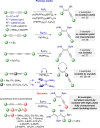[Pt(PPh3)4]-Catalyzed Selective Diboration of Symmetrical and Unsymmetrical 1,3-Diynes
- PMID: 35917577
- PMCID: PMC9396666
- DOI: 10.1021/acs.joc.2c00844
[Pt(PPh3)4]-Catalyzed Selective Diboration of Symmetrical and Unsymmetrical 1,3-Diynes
Abstract
A straightforward, efficient, and selective method for the preparation of novel boryl-functionalized enynes or dienes via [Pt(PPh3)4]-catalyzed diboration of a broad spectrum of symmetrical and unsymmetrical 1,3-diynes was developed. The catalytic cycle of diboration was proposed on the basis of low-temperature 31P NMR studies. An alternative isolation method via product condensation on a cold finger was developed, which, in contrast to previous literature reports, eliminates the need for the additional transformation of rapidly decomposing enynyl pinacol boronates to more stable silica-based column chromatography derivatives during the separation step. To prove the efficiency of this simple catalytic protocol, bisboryl-functionalized enynes were synthesized in a gram scale and tested as useful building blocks in advanced organic transformations, such as hydrosilylation and Suzuki and sila-Sonogashira couplings. The presence of silyl, boryl, as well as other functions like halogen or alkoxy in their structures builds a new class of multifunctionalized enynes that might be modified in various chemical reactions.
Conflict of interest statement
The authors declare no competing financial interest.
Figures





Similar articles
-
Cobalt-Catalyzed Regio- and Stereoselective Hydrosilylation of 1,3-Diynes To Access Silyl-Functionalized 1,3-Enynes.Org Lett. 2019 Jul 5;21(13):5234-5237. doi: 10.1021/acs.orglett.9b01836. Epub 2019 Jun 18. Org Lett. 2019. PMID: 31247801
-
Cu-catalyzed Fe-driven C(sp)-C(sp) and C(s)p-C(sp2) cross-coupling: an access to 1,3-diynes and 1,3-enynes.J Org Chem. 2014 Aug 15;79(16):7391-8. doi: 10.1021/jo5011069. Epub 2014 Jul 25. J Org Chem. 2014. PMID: 25046329
-
Copper(I) hydroxyapatite catalyzed Sonogashira reaction of alkynes with styrenyl bromides. Reaction of cis-styrenyl bromides forming unsymmetric diynes.J Org Chem. 2012 Oct 19;77(20):9379-83. doi: 10.1021/jo3015819. Epub 2012 Oct 8. J Org Chem. 2012. PMID: 23025420
-
Transition metal-catalyzed couplings of alkynes to 1,3-enynes: modern methods and synthetic applications.Chem Soc Rev. 2016 Apr 21;45(8):2212-38. doi: 10.1039/c5cs00892a. Epub 2016 Feb 1. Chem Soc Rev. 2016. PMID: 27086769 Free PMC article. Review.
-
Unsymmetrical 1,1-Bisboryl Species: Valuable Building Blocks in Synthesis.Molecules. 2020 Feb 20;25(4):959. doi: 10.3390/molecules25040959. Molecules. 2020. PMID: 32093409 Free PMC article. Review.
Cited by
-
Pt(PPh3)4 and Pt(PPh3)4@IL catalyzed hydroboration of ketones.Sci Rep. 2023 Nov 19;13(1):20237. doi: 10.1038/s41598-023-47518-6. Sci Rep. 2023. PMID: 37981660 Free PMC article.
References
-
- Miyaura N.; Suzuki A. Palladium-Catalyzed Cross-Coupling Reactions of Organoboron Compounds. Chem. Rev. 1995, 95, 2457–2483. 10.1021/cr00039a007. - DOI
Publication types
MeSH terms
Substances
LinkOut - more resources
Full Text Sources

